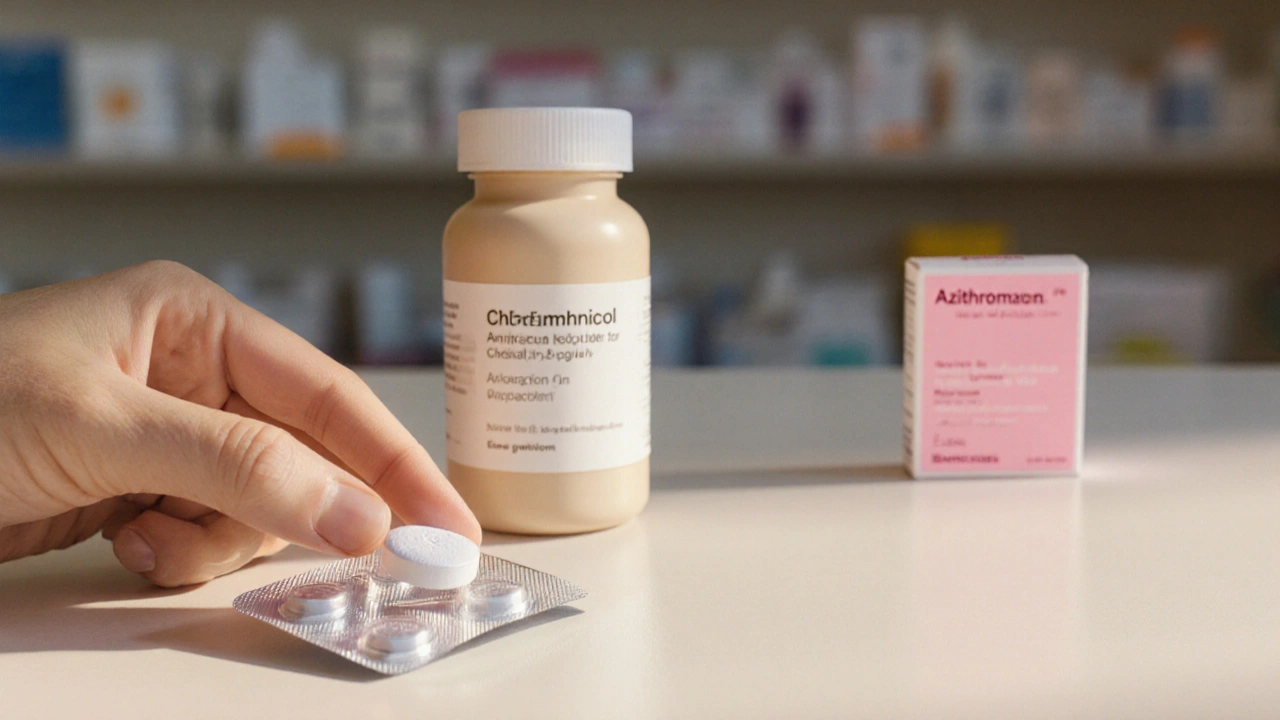- 7
Antibiotic Comparison Tool
Antibiotic Comparison
| Antibiotic | Spectrum | Major Side Effects | CSF Penetration | Safety Profile |
|---|---|---|---|---|
| Chloramphenicol | Gram-positive, gram-negative, anaerobes, rickettsiae | Aplastic anemia, gray baby syndrome, GI upset | Excellent (up to 70% serum levels) | High Risk |
| Amoxicillin | Primarily gram-positive, some gram-negatives | Rash, mild diarrhea, rare hepatotoxicity | Poor (does not cross BBB well) | Safe |
| Azithromycin | Broad, covers atypicals (Mycoplasma, Chlamydia) | QT prolongation, GI upset | Good (moderate CSF levels) | Safe |
| Ciprofloxacin | Excellent gram-negative, some gram-positive | Tendinitis, QT prolongation, CNS effects | Variable (good for meningitis caused by gram-negatives) | Moderate Risk |
| Doxycycline | Broad, especially intracellular pathogens | Photosensitivity, esophagitis, tooth discoloration (children) | Moderate (useful for meningitis in certain strains) | Safe |
| Metronidazole | Anaerobes, protozoa | Metallic taste, neuropathy (long-term), disulfiram-like reaction | Poor (does not reach therapeutic CSF levels) | Safe |
Best for General Infections
Amoxicillin or Azithromycin are preferred due to their excellent safety profiles and wide spectrum coverage for common infections.
Amoxicillin AzithromycinWhen Chloramphenicol May Be Preferred
Chloramphenicol is indicated for specific conditions where other antibiotics are inadequate or contraindicated:
- Meningitis caused by Haemophilus influenzae
- Typhoid fever in resistant strains
- Rickettsial infections when doxycycline unavailable
When a doctor prescribes a broad‑spectrum antibiotic, patients often wonder if there’s a safer or more effective option on the shelf. Chloramphenicol (brand name Chloromycetin) has been a workhorse since the 1940s, but its reputation is mixed because of rare yet serious side effects. This guide walks you through how Chloramphenicol stacks up against the most frequently used alternatives-Amoxicillin, Azithromycin, Ciprofloxacin, Doxycycline, and a few others-so you can understand when it’s a good fit and when another drug might be smarter.
What is Chloramphenicol?
Chloramphenicol is a broad‑spectrum antibiotic that inhibits bacterial protein synthesis by binding to the 50S ribosomal subunit. It was first isolated from Streptomyces venezuelae in 1947 and quickly became popular for treating typhoid fever, meningitis, and various anaerobic infections. Because it reaches high concentrations in the cerebrospinal fluid, it’s still the go‑to oral option for some meningitis cases where other agents struggle to cross the blood‑brain barrier.
Key attributes:
- Typical oral dose: 250‑500mg every 6hours
- Half‑life: 1.5-3hours (varies with liver function)
- Major side effects: bone‑marrow suppression, aplastic anemia, gray baby syndrome
- Resistance: mediated by chloramphenicol acetyltransferase enzymes, fairly common in Enterobacteriaceae
Why Look at Alternatives?
Even though Chloramphenicol works well against many gram‑negative and gram‑positive bacteria, clinicians often reserve it for situations where other antibiotics either fail or cannot be used. The main concerns are its potential for irreversible blood disorders and the fact that its use is limited in pregnant women and children. Alternatives offer similar coverage with fewer safety warnings, but they come with their own trade‑offs, such as increasing resistance patterns or limited tissue penetration.
Brief Overview of Common Alternatives
Amoxicillin is a beta‑lactam penicillin that targets the bacterial cell wall, widely used for ear infections, sinusitis, and some respiratory tract infections.
Azithromycin is a macrolide antibiotic that binds to the 50S ribosomal subunit, prized for its long half‑life and once‑daily dosing.
Ciprofloxacin is a fluoroquinolone that inhibits DNA gyrase and topoisomerase IV, effective against many gram‑negative pathogens.
Doxycycline is a tetracycline derivative that blocks protein synthesis at the 30S ribosomal subunit, commonly used for tick‑borne diseases.
Penicillin is a classic beta‑lactam antibiotic that remains first‑line for streptococcal infections.
Metronidazole is a nitroimidazole that targets anaerobic bacteria and certain protozoa. It’s often paired with other agents for intra‑abdominal infections.

Decision Criteria: What to Compare?
When weighing Chloramphenicol against these alternatives, consider five core dimensions:
- Spectrum of activity: Which bacteria are covered?
- Safety profile: Risk of serious side effects, contraindications, and drug‑drug interactions.
- Pharmacokinetics: Absorption, tissue penetration (e.g., CSF), dosing frequency.
- Resistance trends: Local antibiograms and known mechanisms.
- Cost and availability: Generic status, insurance coverage, and geographic access.
Side‑by‑Side Comparison Table
| Antibiotic | Spectrum | Typical Dose (Adult) | Major Side Effects | CSF Penetration | Resistance Concern |
|---|---|---|---|---|---|
| Chloramphenicol | Gram‑positive, gram‑negative, anaerobes, rickettsiae | 250‑500mg q6h | Aplastic anemia, gray baby syndrome, GI upset | Excellent (up to 70% serum levels) | High (acetyltransferase enzymes) |
| Amoxicillin | Primarily gram‑positive, some gram‑negatives | 500mg q8h or 875mg/125mg BID | Rash, mild diarrhea, rare hepatotoxicity | Poor (does not cross BBB well) | Moderate (β‑lactamase producers) |
| Azithromycin | Broad, covers atypicals (Mycoplasma, Chlamydia) | 500mg day1, then 250mg daily x4 | QT prolongation, GI upset | Good (moderate CSF levels) | Increasing macrolide resistance |
| Ciprofloxacin | Excellent gram‑negative, some gram‑positive | 500mg BID | Tendinitis, QT prolongation, CNS effects | Variable (good for meningitis caused by gram‑negatives) | High fluoroquinolone resistance in many regions |
| Doxycycline | Broad, especially intracellular pathogens | 100mg BID | Photosensitivity, esophagitis, tooth discoloration (children) | Moderate (useful for meningitis in certain strains) | Rising tetracycline resistance in some Enterobacteriaceae |
| Metronidazole | Anaerobes, protozoa | 500mg q8h | Metallic taste, neuropathy (long‑term), disulfiram‑like reaction | Poor (does not reach therapeutic CSF levels) | Low (mostly due to enzymatic activation requirement) |
When Chloramphenicol Still Makes Sense
Despite its safety concerns, there are scenarios where Chloramphenicol is the preferred choice:
- H meningitis caused by Haemophilus influenzae in patients allergic to β‑lactams. Its CSF penetration beats most oral agents.
- Typhoid fever in regions where resistant Salmonella strains dominate. Oral oral Chloramphenicol can still achieve bactericidal levels.
- Rickettsial infections (e.g., RockyMountain spotted fever) when doxycycline is unavailable. The drug’s intracellular activity is comparable.
In these cases, the clinician weighs the rare risk of bone‑marrow toxicity against the immediate need to clear a life‑threatening infection.

Alternatives That Often Win the Trade‑off
For the majority of upper‑respiratory and uncomplicated infections, the alternatives dominate because they are safer, cheaper, and easier to administer:
- Amoxicillin remains first‑line for streptococcal pharyngitis, otitis media, and many community‑acquired pneumonias.
- Azithromycin is favored for sexually transmitted infections and atypical pneumonia due to its once‑daily regimen.
- Ciprofloxacin is the go‑to for complicated urinary tract infections where gram‑negative coverage is critical.
- Doxycycline is the drug of choice for Lyme disease, scrub typhus, and certain resistant gonorrhea cases.
Each of these agents sidesteps the hematologic danger zone that Chloramphenicol inhabits.
Cost, Access, and Practical Considerations
In most high‑income markets, Chloramphenicol is only available as a generic tablet costing about $0.30 per 250mg dose, but many insurers label it as “non‑preferred” and require prior authorization. By contrast, Amoxicillin and Doxycycline are widely stocked in pharmacies, often covered without limits. Azithromycin’s longer course can feel pricier ($1‑$2 per tablet) but insurance formularies typically place it in tier1.
Low‑resource settings may still rely on Chloramphenicol because of its broad coverage and cheap production, especially where newer antibiotics are scarce.
Key Takeaways for Patients and Clinicians
- Chloramphenicol offers unmatched CSF penetration but carries a serious risk of bone‑marrow suppression.
- Amoxicillin, Azithromycin, Ciprofloxacin, and Doxycycline provide safer profiles for most common infections.
- Assess local resistance patterns; fluoroquinolone and macrolide resistance are climbing fast.
- Consider patient‑specific factors: age, pregnancy status, renal/hepatic function, and drug interactions.
- When cost is a major barrier, Chloramphenicol may still be a viable option under close monitoring.
Frequently Asked Questions
Is Chloramphenicol still used in the United States?
Yes, but only for very specific infections like meningitis when other oral agents are unsuitable. The FDA classifies it as a “restricted use” drug, so prescribers must document the justification.
How does the risk of aplastic anemia compare to other antibiotics?
Aplastic anemia from Chloramphenicol is rare (about 1 case per 30,000-40,000 patients) but far higher than the negligible risk with β‑lactams or macrolides. The risk is dose‑independent, meaning even short courses can trigger it.
Can I take Chloramphenicol while pregnant?
No. Chloramphenicol can cause “gray baby syndrome” in newborns and is contraindicated in the third trimester. Safer alternatives like ampicillin or ceftriaxone are preferred.
What monitoring is required during therapy?
Baseline complete blood count (CBC) is essential, followed by weekly CBCs for the first two weeks. Any drop in neutrophils or platelets should trigger immediate discontinuation.
How does resistance to Chloramphenicol develop?
Bacteria acquire a chloramphenicol acetyltransferase (CAT) enzyme that inactivates the drug. Plasmid‑mediated CAT genes spread quickly among Enterobacteriaceae, making resistance common in hospitals.


Halle Redick
October 6, 2025 AT 16:51Wow, this comparison really helps to demystify the whole chloramphenicol saga! I love how the table breaks down the safety profile versus the CSF penetration – it’s super clear. For anyone juggling a nasty infection, it’s good to know when the risk might actually be worth it. And the bit about cost in low‑resource settings is a nice reality check. Keep sharing these practical guides, they’re gold for the everyday person.
Erica Harrington
October 15, 2025 AT 23:15The practical tone of this guide makes it really approachable. Seeing the side‑by‑side table helps compare the trade‑offs at a glance. It’s also great that the author notes when chloramphenicol is truly indicated, not just a fallback.
Patricia Mombourquette
October 25, 2025 AT 08:26Ths post is well‑organized but its grammar is liitle off, expecially the misuse of "its" vs "it’s". Also, the phrase "chloramphnicol" is misspelled in a few places. The info is good though but a proofread would help.
karl lewis
November 3, 2025 AT 12:03One might argue that the risk of aplastic anemia outweighs the modest benefits in most cases. Nevertheless, the author presents a balanced view, which is commendable. :)
Amy Martinez
November 12, 2025 AT 18:27Reading through this guide felt like strolling through a vibrant garden of medical knowledge, each flower representing a different antibiotic and its unique hue. The author paints chloramphenicol as a daring adventurer – bold, capable of traversing the blood‑brain barrier with ease, yet haunted by the specter of bone‑marrow toxicity that looms like an ominous storm cloud. In contrast, amoxicillin appears as the reliable village doctor, gentle and familiar, ready to treat common ailments without demanding heavy monitoring. Azithromycin, with its long half‑life, is the charismatic storyteller who can stay in the narrative longer, while ciprofloxacin takes on the role of the sharp‑eyed detective, hunting down gram‑negative villains but sometimes stepping on nervous system landmines. Doxycycline emerges as a versatile scout, slipping into intracellular hideouts and battling rickettsial foes with a sunlight‑sensitive shield that reminds patients to wear hats on bright days. Metronidazole, the underground operative, targets anaerobic hideouts with a metallic‑tainted whisper, reminding us that not all heroes wear capes – some carry a resistant taste. The meticulous side‑by‑side table is a masterstroke, allowing readers to compare spectrum, dosage, and side effects at a glance, akin to comparing the specs of different spacecraft before a launch. Moreover, the discussion of cost and accessibility adds a pragmatic layer, acknowledging that in low‑resource settings, chloramphenicol might still be the trusty workhorse despite its shadows. The author’s candid note about monitoring – baseline CBCs and weekly checks – serves as a gentle reminder that vigilance is the true guardian of safety. Finally, the FAQ section ties up loose ends, demystifying gray baby syndrome for the curious mind and clarifying contraindications in pregnancy, ensuring that both clinicians and patients walk away with a clearer map of when to wield chloramphenicol’s power. Overall, this piece not only educates but also empowers, inviting readers to navigate the antibiotic landscape with confidence and nuance.
Josh Grabenstein
November 22, 2025 AT 00:51Interesting how the pharma giants push the newer drugs while older ones like chloramphenicol get a bad rap. The data is solid but remember who funds the research. Also the CSF penetration numbers sometimes hide the real variability in patients.
Marilyn Decalo
December 1, 2025 AT 07:15Okay, let’s get real: the drama around chloramphenicol is blown out of proportion in most circles. The fear of aplastic anemia is real, but it’s also hyperbolic when you consider the incidence. If you’re treating a resistant meningitis case where beta‑lactams fail, this drug can be a lifesaver, and that’s no small thing. Meanwhile, azithromycin’s QT prolongation worries get the same sensational headlines, yet it’s routinely used without daily ECGs. The table does a great job balancing pros and cons, but don’t forget local antibiograms – they can flip the script entirely. In low‑resource hospitals, the cheap price of chloramphenicol means it stays on the shelves, and doctors there weigh the risk versus the alternative of no effective therapy. Also, the cost comparison segment is a nice touch; many don’t realize the insurance hurdles for the “safer” options. Finally, the monitoring guidelines are on point – you need to keep an eye on CBCs, but the protocols are often ignored in practice, which is a tragedy of its own.